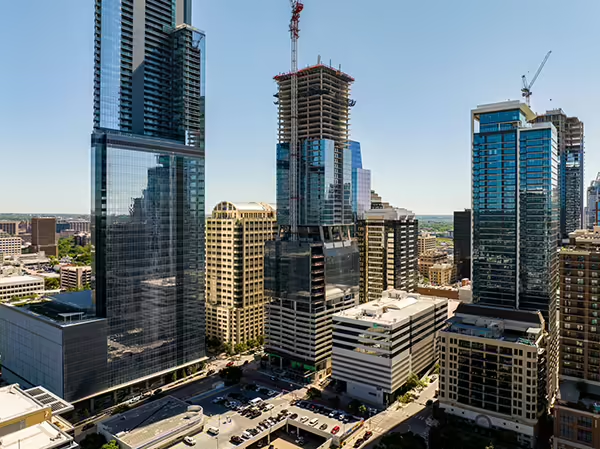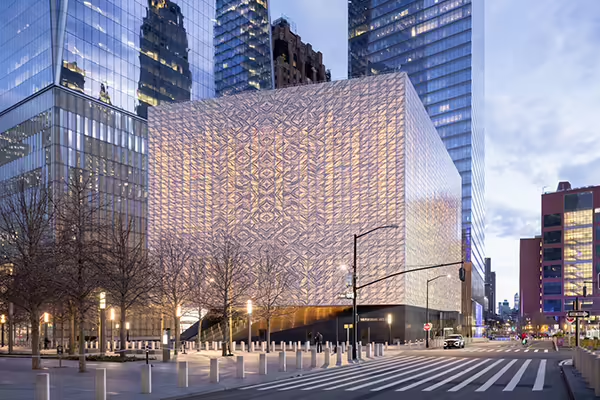Timeline
1920 - 1929
Seattle in 1920 enjoyed a new era of cultural, social, and economic growth never seen in the Pacific Northwest. During this time of promise and excitement, our firm’s founder, William Henry Witt, moved across the country in search of his own American dream and eventually decided to start his engineering practice. The firm we know today as Magnusson Klemencic Associates, an internationally recognized, award-winning engineering company, was born.
1920
W. H. Witt founds company in Seattle, WA

1920-1922
Office Location: Securities Building

1922-1927
Office Location: Seaboard Building

1923
Harold Worthington and George Runciman hired

1927-1960
Office Location: Lloyd Building

1928
Firm formally named the W. H. Witt Company
1930 - 1939
In the 1930s, America, Seattle, and the W. H. Witt Company were hit by the Great Depression, which lasted until 1939 and represented the industrialized world’s worst economic downturn. Companies struggled, banks failed, stores closed, unemployment surged, and engineering projects halted as financing dried up. Washington’s lumber industry crashed without the previous decade’s construction boom. Seattle’s structural engineering and architecture firms closed their doors one by one. Yet, the W. H. Witt Company endured through perseverance, sacrifice, and risk.
1930-1931
Two Seattle projects—the Textile Tower and the Seattle City Light Building—provide the majority of the firm’s income between late 1930 and early 1931

Keeping Afloat
Small steel detailing projects from contractors and fabricators such as Howard S. Wright & Son, Sound Construction and Engineering, Pacific Coast Steel, and West Coast Construction Company (billed for as little as $3 per job) keep the company afloat during the Depression and between larger projects
The New Deal’s infrastructure funding and the Cullen-Harrison Act legalizing beer and wine (ending 13 years of American prohibition) save the company as the firm is hired to build bridges and breweries in Washington

1933
Hailed as America’s longest reinforced concrete span (exclusive of arches), the McMillin Bridge in Pierce County, WA, receives national acclaim in Engineering News-Record

1934
With a central span of 190 feet, the Purdy Bridge in Purdy, WA, is believed at the time to be the longest box girder bridge ever built

1936
The firm designs bottling houses for Rainier Brewing Company in Seattle, WA, and the Olympia Brewing Company in Tumwater, WA

1940 - 1949
Following World War II, the W. H. Witt Company accompanied its architectural clients and expanded its client base into the Alaska Territory to meet postwar demand, resulting in a miniature Klondike Gold Rush. War-era military personnel and construction workers arrived in Alaska by the thousands and decided to stay, creating demand for homes, schools, hospitals, and churches.
In 1945, Harold Worthington and George Runciman quietly celebrated 18 years of partnership under the flag of the W. H. Witt Company.
In November 1945, Worthington and Runciman amicably agreed to separate the firm’s accounts into “Old Witt Co.,” “New Witt Co.,” and “George Runciman.”
1946
Joe Jackson and John Skilling hired

1947
Helge Helle hired

1947
The Loussac-Sogn Building is the largest commercial building in Anchorage, AK, upon completion

1950 - 1959
In the postwar building boom of the 1950s, architects reeled in commissions from developers and owners, resulting in the W. H. Witt Company’s swift uptake of new projects. Buildings were constructed more economically by contractors who respected Worthington & Skilling’s efficient structural designs. After enjoying their experience and being impressed with the innovation, architects and owners returned for more. The firm added the innovative minds of many talented individuals this decade, including Jack Christiansen, Bill Ward, Kent Rogers, and Les Robertson, and added a Civil Engineering practice.
1952
Jack Christiansen hired

1954
Bill Ward hired

1955
Skilling teams up with architect NBBJ and general contractor Howard S. Wright & Company to build for Boeing a massive B-52 hangar with a thin-shelled concrete roof

1955
The firm name changes to Worthington & Skilling three years after Skilling is made partner
1956
The Yakima Junior High School Gymnasium in Yakima, WA, represents America’s first thin-shell, pre-stressed concrete structure

1957
Kent Rogers hired

1958
Worthington & Skilling adds a Civil Engineering practice, which is overseen by Bill Ward

1958
Les Robertson hired

1960 - 1969
The dawn of the 1960s revealed space exploration, scientific advancements, and political energy unlike any decade prior. The Space Race captivated the world, evidenced by the many attractions underway at the Century 21 Exposition / Seattle World’s Fair. The engineering world also reached new heights as Worthington, Skilling, Helle & Jackson was commissioned to design the world’s tallest buildings—the World Trade Center towers in New York City.
1960
Firm name changes to Worthington, Skilling, Helle & Jackson
1960-1973
Office Location: Washington Building

1961
The firm engages with Minoru Yamasaki for the iconic U.S. Science Pavilion at the Century 21 Exposition / Seattle World’s Fair

1962
Art Barkshire hired

1963
The United Steelworkers Building (IBM Building) in Pittsburgh, PA, marks the first exterior space frame office building and the first use of 100,000-psi high-strength steel

1967
Firm name changes to Skilling, Helle, Christiansen, Robertson

1969
The Rivergate Convention Center in New Orleans, LA, features America’s largest cylindrical shell roof and earns an Honor Award from the American Consulting Engineers Council

1970 - 1979
As many Americans continued to fight for expanded social and political rights, the country also saw a shift away from politics and turn toward pop culture. In the engineering world, the success of NASA’s space program encouraged many young people to pursue careers in STEM from the late 60s through the 70s. However, the country’s recession from 1973 to 1975 ended the postwar boom enjoyed for the last several decades, and the oil crisis of this period shifted the nation’s priorities toward energy and conservation. Jack Christiansen’s beautiful thin-shelled roofs began to fade out, and in came the era of steel domination and its economic viability, given international competition and trade globalization.
1972
New York City’s World Trade Center Towers are the world’s tallest buildings at the time of completion and the first to use prefabricated, multiple-column-and-spandrel steel wall panels and mechanical damping units to reduce wind “excitation”; it also is the first project to perform comprehensive studies surrounding wind environments and human sensitivity to building motions, as well as boundary layers utilizing wind tunnel testing

1973
The Federal Reserve Bank in Minneapolis, MN, is the world’s first catenary-supported, clear-span building

1974-1989
Office Location: Financial Building

1975
The firm is engaged for its first international project (Jubail, Saudi Arabia)

1976
Jon Magnusson hired

1976
The Kingdome in Seattle, WA, is the largest concrete dome ever built

1978
Rainier Tower in Seattle, WA, marks the first high-rise building supported by a flared pedestal

1980 - 1989
Beyond political tensions of the ongoing Cold War, increasing popularity of “Reaganomics,” and the age of entertainment, one of the most significant shifts of the time was the personal computer. As Apple launched its Macintosh and Silicon Valley became the hub of technological advancement, the engineering world saw ever-increasing opportunities. Programs like FORTRAN allowed Skilling to employ the benefits of computer-optimized designs on innovative projects like Columbia Center and Century Square in downtown Seattle.
1983
Firm name changes to Skilling Ward Rogers Barkshire

1986
Columbia Center in Seattle, WA, represents the first high-rise tower designed with composite columns at the apexes to reduce wind sway in a triangular-braced building

1988
The Washington State Convention & Trade Center in Seattle, WA, incorporates the first-ever specially designed trusses in its design to create a “building-bridge” over a major highway

1988
Firm name changes to Skilling Ward Magnusson Barkshire (SWMB)

1989-1992
Office Location: Pacific First Centre

1989
Two Union Square in Seattle, WA, is the first building to use steel pipes filled with a world-record-breaking, high-strength, 19,000-psi concrete and hyper-efficient, viscoelastic dampers

1990 - 1999
Building on the previous decade’s success, cost savings, and innovations, SWMB had a solidified reputation as one of the most prominent engineering firms entering the 1990s. A decade remembered as both comfortable and transformative, technology and the growing power of the internet changed everything from politics and domestic life to business and the economy. With an ever-expanding project portfolio, the firm capitalized on its “Market Sector” approach to diversify pursuits and expand the talent pool of experts in particular building types.
1992
Ron Klemencic hired

1992-Present
Office Location: Rainier Tower

1994
The American Institute of Architects (AIA) confers John Skilling with an Honorary AIA Member (one of the highest honors bestowed upon a non-architect); Seattle Mayor Norm Rice proclaims June 3, 1994, “John Skilling Day” in Seattle, congratulating the city’s “creative and remarkable man”

1996
KeyArena in Seattle, WA, earns the American Council of Engineering Companies (ACEC) Grand Conceptor Award

1997
The Hawaii Convention Center in Honolulu, HI, is the first to incorporate a full-building-depth “super-truss” structural system into its design

1998
The Asian Star Building in Muntinlupa, Metro Manila, Philippines, is the world’s first new high-rise building to incorporate Performance-Based Seismic Design (PBSD)

1999
Safeco Field in Seattle, WA, features the first fully retractable stadium roof structure with linear tracking and independent roof panels

2000 - 2009
The end of one century and the beginning of another…While innovation and technology peaked, challenges such as the economic recession and the 9/11 terrorist attacks rocked the decade, heavily impacting the firm and the industry. Yet, some of our most accomplished, award-winning, world-class designs emerged. Strength of leadership, commitment to designing the best projects in the world, and reinvestment in international projects allowed the firm to endure.
2000
Key Center in Bellevue, WA, is America’s first new construction high-rise building designed using PBSD

2000
Following the construction of Safeco Field, the Kingdome in Seattle, WA, is demolished to make room for another firm project, the new Seahawks Stadium and Exhibition Center

2001
The 9/11 terrorist attacks leave the country shocked and heartbroken when two Boeing 767 airplanes hit the firm-designed World Trade Center Towers

2002
The Highcliff in Hong Kong represents the world’s tallest residential tower upon completion, built for typhoon conditions and incorporating tuned liquid “sloshing” dampers to control wind acceleration

2003
Firm name changes to Magnusson Klemencic Associates (MKA)

2003
MKA opens Chicago office
2005
111 South Wacker in Chicago, IL, marks the world’s first high-rise with a certified LEED Gold Core and Shell

2006
The U.S. Federal Courthouse in Seattle, WA, earns ACEC’s Grand Conceptor Award

2007
MKA’s Green Roof Evaluation Project in Seattle, WA, an unprecedented, three-year research collaboration proving the stormwater benefits of green roofs, earns an ACEC Grand Award

2008
Olympic Sculpture Park in Seattle, WA, earns ACEC’s Grand Conceptor Award


2009
The vertical, first-of-its-kind Dee and Charles Wyly Theatre in Dallas, TX, offers complete flexibility and movable components

2010 - 2019
The 2010s revealed a clash of ideologies, affluence, and technology. In a post-9/11 world, many projects focused on safety, security, and design excellence, and an increasing awareness of climate change pushed the industry towards more sustainably‑ conscious designs. MKA’s determination and innovative contributions to many notable, large-scale projects lifted the firm from the struggles of the Great Recession into a new era of success and profitability.
2010
Mineta International Airport Terminal B and Concourse, in San Jose, CA, is the first major airport to use a special truss moment structural system

2012
City Creek Center in Salt Lake City, UT, features one of the “world’s most intricate” fully retractable roof structures

2014
Levi’s Stadium in Santa Clara, CA, employs an Advanced Delivery Method fast track schedule to deliver the fastest NFL stadium upon its completion and MKA’s quickest-designed large project

2014
The LEED Platinum San Ysidro U.S. Land Port of Entry in San Ysidro, CA, is MKA’s largest civil project at the time of award and features “net zero” for all non-potable water and zero discharge for stormwater

2016
MKA Foundation launched

2016
MKA’s story is documented and published in the book We Had to Be Dreamers: A Century in Engineering Leadership, authored by Sybil Hatch and Tyler Sprague

2016
T3 Minneapolis in Minneapolis, MN, is America’s first heavy-timber high rise

2017
150 North Riverside in Chicago, IL, utilizes the highest-capacity H piles ever used in the city, features the world’s largest rolled steel sections (W36x925), and the first use of 70-ksi steel in America

2017
The Amazon Spheres in Seattle, WA, marks a first-of-its-kind structural system constructed from organically shaped steel Catalan sections

2018
Salesforce Tower in San Francisco, CA, is the tallest building west of the Mississippi River (based on the highest occupied floor)

2019
The American Society of Civil Engineers (ASCE) / Structural Engineering Institute (SEI) releases the Prestandard for Performance-Based Wind Design (PBWD), to which the MKA Foundation was a major contributor

2019
Launch of the Embodied Carbon in Construction Calculator (EC3) tool, for which MKA was a lead funder and part of the executive leadership team

2020 - Present
MKA celebrated 100 years as a company at the start of the decade. The country was also plunged into the chaos of the COVID-19 Pandemic, forcing worldwide shutdowns and economic challenges. While COVID-19 has forever impacted the world, we know from over 10 decades of lessons learned that change is inevitable and challenges spark innovation. Our eyes are on the next frontier and the adventures and collaborations ahead!
2020
Rainier Square in Seattle, WA, marks the first application of SpeedCore in a high-rise structure

2020
MKA celebrates 100 Year Anniversary

2020
MKA becomes a signatory of the SE 2050 Commitment
2021
St. Regis Chicago in Chicago, IL, is the city’s third tallest building at 1,200 ft

2021
The three-story Las Vegas Convention Center Expansion Phase 2 in Las Vegas, NV, features 270-ft trusses and an architecturally expressive “sno-cone” roof spanning 500 ft and cantilevering 150 ft

2022
Hines engages MKA to create the Hines Carbon Reduction Playbook, a company guide published globally and featuring additional training sessions, case studies on current Hines projects, and the development of a database for future carbon accounting

2022
The 14-acre Presidio Tunnel Tops park in San Francisco, CA, is built over the Presidio Parkway Main Post Tunnels and reconnects the Presidio to the waterfront for the first time in nearly 80 years

2023
The Beaudry in Los Angeles, CA, is an early test case for the EC3 tool, preventing approximately 13,650 metric tons of verifiable equivalent carbon dioxide from being released into the atmosphere during construction and at no additional cost to the owner
2023
MKA’s Seattle office undergoes a complete upgrade during a major Tenant Improvement project

2023
MKA names David E. Eckmann, SE, PE, FAIA as President

2024
MKA’s design of ATX Tower (321 W. 6th Street in Austin, Texas) is the first Performance-Based Wind Design (PBWD) high-rise tower to be reviewed and permitted using ASCE’s rigorous Prestandard — by understanding PBWD-related structural behaviors and optimized use of materials, MKA used this innovative and groundbreaking technique to save millions of dollars in construction costs while reducing environmental impacts

2024
National Council of Structural Engineers Associations (NCSEA) awards the Perelman Performing Arts Center (PAC NYC) 2024 “Structure of the Year,” as well as “Best New Building Over $200 Million” — simple and reverent during daylight, the marble-and-glass façade illuminates at night, revealing what lies within—a one-of-a-kind venue capable of internally transforming into near-limitless configurations thanks to an ingenious structural system
